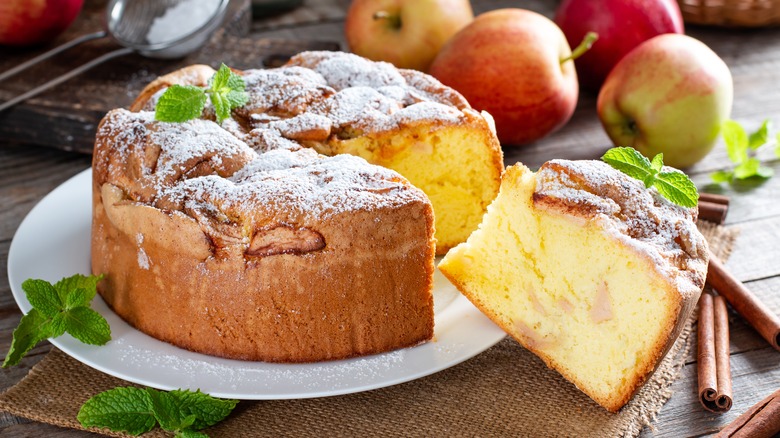What Makes Chiffon And Sponge Cake Different?
There are seemingly more baked goods under the sun than stars in the sky. Inevitably, this means you're going to be left with some types of cakes that are distinct from each other while still being remarkably similar. Not everything can be as obviously different as German chocolate cake and carrot cake; sometimes things are pretty close together. Such is the case with chiffon cake and sponge cake.
But what even is the difference between these two? They both tend to be light and airy, and both are popular in the American South. The answer comes down to butter and baking powder — specifically, that sponge cakes don't have any of either, while chiffon cakes have both. But it's not as simple as "chiffon cakes are butter cakes," either. Butter cakes are a category of cakes that sit in opposition to sponge — but chiffon cakes are kind of down to a category all to themselves.
Sponge cakes rely on eggs for leavening
In order to understand how chiffon cake and sponge cake diverge, it's important to first understand butter cakes vs. sponge/foam cakes. The primary difference between these two is the ingredients and how you treat them. Sponge cakes — a type of foam cake (and the terms are often used interchangeably) — have pretty much the simplest ingredient list you'll ever see in a baked good: eggs, sugar, and flour.
There's no leavening agent here; instead, the eggs themselves are used as the leavening agent. This typically involves beating the eggs with sugar until they've formed about twice the total volume. You're dealing with whole eggs here, not separating them as with many recipes, which means overmixing isn't nearly as much of a concern. Butter cakes, meanwhile, do involve butter or oil and significant amounts of it. A classic buttery pound cake, for instance, gets its name from the fact it involves a pound of each of its ingredients (including butter). This results in denser cakes than sponges but with richer flavors.
One additional note: Sponge cakes in America are very different from sponge cakes in the United Kingdom. U.K. sponge cakes frequently do include butter, while the term "foam cake" is reserved for cakes that don't.
Chiffon cakes are a hybrid between sponge and butter cakes
Chiffon cake splits the difference between the two. Invented in 1920 by a guy named Harry Baker (talk about destiny considering the profession he went into), chiffon cake was intended to be even lighter and more delicate than angel food cake. It's sometimes classified as a sponge cake, but that's not quite right.
Chiffon cakes do involve butter or oil, but the key difference is in how the eggs are treated. Instead of being beaten whole, the yolks get beaten together with the other ingredients, while the egg whites are beaten separately into a meringue. This meringue is then folded back into the rest of the batter. The meringue, combined with baking powder, means the cake has a lightness that can't be achieved by most sponge or butter cakes.
Sponges and chiffons have their uses, though chiffons are clearly a bit trickier to make. Give them a try for yourself and see which you prefer.


